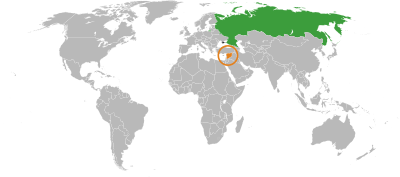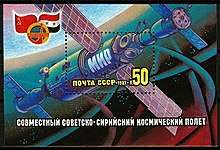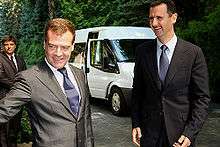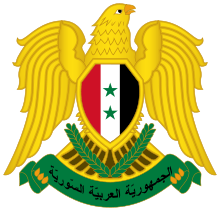Russia–Syria relations
Russia–Syria relations refers to the bilateral relationship between Russia and Syria. Russia has an embassy in Damascus and Syria has an embassy in Moscow. Russia enjoys a historically strong, stable, and friendly relationship with Syria, as it did until the Arab Spring with most of the Arab countries.[1] Russia's only Mediterranean naval base for its Black Sea Fleet is located in the Syrian port of Tartus.[2]
 | |
Russia |
Syria |
|---|---|
Diplomatic relations between the Soviet Union and Syria were established in July 1944, and an agreement was signed in February 1946 ensuring Soviet support for Syrian independence ahead of the evacuation of French troops in April 1946.[3] During World War II, both countries were in the Allied side against the Axis powers.
In 1971, under an agreement with President Hafez al-Assad, the Soviet Union was allowed to open its naval military base in Tartus,[4][5] a facility the former Soviet republic continues to use to this day. On 8 October 1980, Syria and the Soviet Union signed a Treaty of Friendship and Cooperation.[6] The treaty runs for twenty years and has automatic five-year extensions, unless one of the parties terminates the agreement. It provides for regular consultations on bilateral and multilateral issues of interest, coordination of responses in the event of a crisis, and military cooperation.[7] The treaty remains in force to this day.[8] In January 1992, the Syrian government recognized the Russian Federation as the legal successor to the Soviet Union.
Russia in 2011 and 2012 used its veto-power in the United Nations Security Council against resolutions promoted by Western and Arab countries, to prevent possible sanctions or military intervention against the Syrian government, and Russia continued supplying large amounts of arms that Syria's government had earlier contracted to buy and which were used to fight Western-backed rebels.[9] On 30 September 2015, Russia began a military intervention in the Syrian Civil War in support of the al-Assad government, consisting of air strikes against terrorist groups, e.g.: ISIS, as well as well as civilian and military targets in opposition-held territory. [10]
Political relations
Before 1944
In 1893, the Russian Empire established a consular office in Damascus, then a part of Ottoman Syria.[11] Following the October Revolution (1917), and the creation of the Soviet Union (1922), the Russian presence in Syria came to an end, which continued during the French Mandate period (1923−1946). Although the Soviet Union did not play a political role in the region, it did promote the establishment of the Syrian–Lebanese Communist Party in 1924.[11]
1944–1958
Diplomatic relations between the Soviet Union and Syria were established in July 1944. The Soviet Union commenced to again take an interest in the Middle East after the Second World War. The two countries signed a secret agreement on 1 February 1946,[3] with Soviet minister to Syria and Lebanon Daniel Solod as signatory for the USSR, in which the Soviet Union agreed to provide military help in the formation of the Syrian Arab Army and prescribed Soviet diplomatic and political support in the international arena. The Soviet Union demonstrated its commitment to this treaty with Andrey Vyshinsky's 15 February 1946 address to the United Nations Security Council calling for the removal of British and French troops from the country.[12] The last French troops were removed from Syria on 17 April 1946. During the Cold War (1947–1991) a stronger political bond developed, and Syria was considered an ally to the Soviet Union in opposition to the Western powers.[13]
In 1949, after the 1948 Arab–Israeli War, Syria experienced a number of military coups and the rise of the Ba'ath Party. Three coups d'état occurred by 1953, ushering in military dictatorships twice in the process. A non-aggression pact was signed on 10 April 1950 further cemented Soviet–Syrian ties. During the Cold War period, each conflict and war that broke out in the Middle East acted as a factor leading Syria to form closer ties with the Soviet Union. Following the military coup d’état of 25 February 1954, the Ba'ath Party came to the fore in Syrian politics.
The West-inspired Baghdad Pact (1955), with its ultimately unsuccessful formation of the Central Treaty Organization, brought Soviet-Syria relations closer diplomatically. Syrians however perceived this agreement as a pact against themselves. Indeed, among the consequences of the Baghdad Pact was not only a deepening of Syrian relations with the Soviet Union but also an alignment of Middle Eastern countries into allied satellites of the Eastern and Western blocs.
The response of the Soviet Union to the Suez Crisis (late October 1956) increased Soviet prestige in the Middle East. Soviet aid to Syria accelerated and included military and economic agreements. Between 1955 and 1958, Syria received about $294 million from the Soviet Union for military and economic assistance.[11] Simultaneously, the Ba'ath Party in Syria increased its power and influence.[14]
1966–2010


The Syrian coup d'état of February 1966 gave the Soviet Union the opportunity to further support Syria. A new coup d’état in 1970, called the Corrective Movement, brought Hafez Assad to power in Syria on 13 November 1970.[15]
In 1971, under an agreement with President Hafez al-Assad, the Soviet Union was allowed to open its naval military base in Tartus, giving the Soviet Union a stable presence in the Middle East.[4][5] Thousands of Syrian military officers and educated professionals studied in Russia during al-Assad's presidency (1971–2000).[16]
In April 1977, Hafez al-Assad visited Moscow and met with Soviet leaders Leonid Brezhnev and Alexei Kosygin among others, as a sign of improved Syrian relations with the USSR. In October 1980, Syria and the Soviet Union signed a twenty-year Treaty of Friendship and Cooperation.[6]
Hafez al-Assad died on 10 June 2000 and was succeeded on 10 July 2000 by his son Bashar al-Assad, who was elected President by referendum in which he ran unopposed, garnering 97.29% of the vote.
Since the Syrian Civil War (2011–present)
_22.jpg)
During the Syrian Civil War which began in 2011, Russia with China in February 2012 voted against a formal UN Security Council condemnation of the Bashar al-Assad government for alleged attacks on civilians in the city of Homs.[17] In 2018, Russia announced free military education for Syrian kids chosen on merit. The first batch of 8 Syrian kids reached St. Petersburg in August.[18]
Military cooperation
Russian naval base in Tartus
The Russian naval facility in Tartus, Syria, was established during the Cold War under a 1971 agreement with Syria. It is Russia's only naval facility in the Mediterranean region and the only remaining military facility outside the former Soviet Union.
After Russia forgave Syria 73%, or $9.6 billion, of its $13.4 billion Soviet-era debt in 2005[19] and became its main arms supplier, Russia and Syria at the end of the 2000s conducted talks about allowing Russia to upgrade and expand the facility at Tartus.[20] Amid Russia's deteriorating relations with the West, because of the 2008 South Ossetia War and plans to deploy a US missile defense shield in Poland, President Assad agreed to the port's conversion into a permanent Middle East base for Russia's nuclear-armed warships.[21]
Since 2009, Russia has been renovating the Tartus naval base and dredging the port to allow access for its larger naval vessels.[22]
On 18 January 2017, Russia and Syria signed an agreement, effective forthwith, whereunder Russia would be allowed to expand and use the naval facility at Tartus for 49 years on a free-of-charge basis and enjoy sovereign jurisdiction over the base.[23][24][25] The treaty allows Russia to keep 11 warships at Tartus, including nuclear vessels;[26] it stipulates privileges and full immunity from Syria's jurisdiction for Russia's personnel and materiel at the facility.[27] The treaty was ratified and approved by Russian parliament, and the relevant federal law was signed by president Vladimir Putin by the end of December 2017.[28][29][30]
Russian air base in Palmyra
Russia had in 2013 an airbase in Palmyra (Tadmur).[31]
Russian air base at Latakia
In 2015 Russia established the Khmeimim Air Base at Latakia.
Russian weapons sales
See under section Economic relations ; Arms sales.
Secret Russian spy bases
The journal Jane's Defence Weekly in 2006 assumed two secret, joint, Russian–Syrian signals intelligence ‘spy’ posts to exist within Syria.[32] The biggest Russian electronic ‘eavesdropping post’ outside Russian territory was in 2012 established in Latakia.[33]
Another signals intelligence base, "Center S" ("Центр С" in Cyrillic script), jointly operated by the Russian OSNAZ GRU radio electronic intelligence agency and a Syrian intelligence agency, situated near Al-Harra in Syria close to the Israeli-occupied Golan Heights, was on 5 October 2014 captured by Free Syrian Army rebels during the Daraa offensive (October 2014).[32][34]
Syria’s air defence with Russian equipment
After the 2007 Israeli Operation Orchard airstrikes on an alleged nuclear reactor at al-Kibar in Deir ez-Zor Governorate, and again after the March 2011 Syrian protests, Syria's air defences have been bolstered with Russian upgrades—which the Russians have repeatedly denied. According to Western experts, the Russians delivered Buk-M2 and Pantsir-S1 (also known as SA-22) mobile missile launch and radar systems. While the Syrians were not capable of using such equipment to its full capacity, the Russians also helped man the crews and train the crews. As of late 2012, Syria's air-defence command force comprised thousands of anti-aircraft guns, 130 anti-aircraft missile batteries, and an estimated 50,000 troops, and was qualified by the Guardian as "robust".[33]
2015 Russian military intervention
On 30 September 2015, Russia began a military intervention in the Syrian Civil War in support of Bashar al-Assad's government, consisting of air strikes against Syrians that oppose the government. In addition, ISIS and Assad's Regime fight against opposition groups (FSA). With Vladimir Putin's support, Assad's troops are fighting Free Syrian Army all throughout the country.[35] Expressing Russian, Iranian, and Syrian support for each other, the Chairman of the Iranian parliament's, (aka Islamic Consultative Assembly or Majlis) National Security and Foreign Policy Committee — Heshmat-Allah Falahat Pishe — stated during an interview on Russia Today TV on February 1, 2019: "Russian, Iranian, and Syrian soldiers shed their blood together in Syria. ... I do now know why the Russians hesitate to say that our relationship is strategic. We have fought together and Russia is under American sanctions, just like us. In order to deal with that, we expect more cooperation from the Russian side."[36]
In May 2019, The Moscow Times reported that "Fifty-five percent of Russian respondents say their country should end its military campaign in Syria, up from 49 percent in August 2017, according to a poll published by Levada".[37]
Economic relations
Russia has significant economic interests in Syria. Its investments in the country were valued at $19.4 billion in 2009, according to The Moscow Times, and its exports to Syria were worth $1.1 billion in 2010.[38][39]
Arms sales
The Soviet Union’s military sales to Syria in the 1970s and 80's accounted for 90% of all Syrian military arms imports, according to a United States Congressional Research Service Report released in 2008.[40] The report noted that Syria purchased several billions of dollars' worth of military equipment from the Soviets, including SS-21 "Scarab" short-range missiles (range 70 km).[40]
After the collapse of the Soviet Union in 1991, Syria found itself deprived of arms imports, but continued to seek them through former Soviet satellite states.[40] The establishment of the Russian Federation in 1992 saw the re-introduction of the patron-vendor relationship and the cancellation of almost 73% of Syria's debt.[40] According to reports, 2.4% of Russia's total exports come from defense-related sales.[41]
From 2000 to 2010, Russia sold around $1.5 billion worth of arms to Syria, making Damascus Moscow's seventh-largest client, according to Dmitri Trenin in the New York Times.[17]
In 2008, Syria agreed to purchase modern weapons including modern anti-tank and anti-air missile systems from Russia, including MiG-29SMT fighters, Pantsir S1E air-defense systems, Iskander tactical missile systems, Yak-130 aircraft, and two Amur-1650 submarines. Russia's foreign minister Sergei Lavrov said his country's sale of weapons to Syria would not upset the balance of power in the Middle East. The sales he stated are "in line with the international law" and "in the interests of strengthening stability and maintaining security" in regions close to Russian borders, Lavrov told reporters.[42]
During the 2011 Syrian uprising, Russia has allegedly shipped arms to Assad's government for use against rebels.[43]
Syria's arms contracts with Russia in 2011 and 2012 amounted to $687 million, according to the Stockholm International Peace Research Institute (SIPRI).[44] But according to The Moscow Times, Russia and Syria had in 2011 well over $4 billion in active arms contracts.[45]
Other economic sectors
Russian firms in 2011 had a substantial presence in Syria's infrastructure, energy and tourism industries.[45] Stroitransgaz, a natural gas facility construction company, has the largest Russian operation in Syria. In 2010, it was involved in projects worth $1.1 billion and had a staff of 80 Russians working in Syria. Stroitransgaz is building a natural gas processing plant 200 kilometers east of Homs in the Raqqa region and is involved in technical support for the construction of the Arab Gas Pipeline. Tatneft is the most significant Russian energy firm in Syria. The company began in 2010 through a joint venture with the Syrian national oil company to pump Syrian oil and it planned to spend $12 million on exploratory wells near the Iraqi border.[38] Other firms with large business interests in Syria include steel pipe manufacturer TMK, gas producer ITERA, and national carrier Aeroflot.[45]
See also
- Embassy of Russia in Damascus
- Embassy of Syria in Moscow
- List of ambassadors of Russia to Syria
- Russia's role in the Syrian conflict
- China–Syria relations
References
- Russia clings on to last outpost in West Asia| Pionner| 3 February 2012
- contribution to ‘What Should the United States Do About Syria?: A TNR Symposium.’| Daniel W. Drezner| tnr.com| 9 February 2012
- Ginat, Rami (Apr 2000). "The Soviet Union and the Syrian Ba'th Regime: From Hesitation to Rapprochement". Middle Eastern Studies. 36 (2): 150–171.
- International New York Times, 3 October 2015.
- Breslauer, George W. (1990). Soviet Strategy in the Middle East. Boston, Massachusetts.
- Lea, David (2001). A Political Chronology of the Middle East. London, United Kingdom: Europa Publications.
- Relations with the Soviet Union
- Syria, USSR Treaty of Friendship, Cooperation Which Remains in Force
- Why Russia is willing to sell arms to Syria By Fred Weir| csmonitor.com| 19 January 2012
- Russia Bombing Syrian Hospitals
- Kreutz, Andrej (2007). Russia in the Middle East: friend or foe?. Westport, Connecticut: Greenwood Publishing Group.
- Ginat, Rami (Oct 1996). "Soviet Policy towards the Arab World, 1945-48". Middle Eastern Studies. 32 (4): 321–335.
- Trenin, Dmitri (5 February 2012). "Russia's Line in the Sand on Syria: Why Moscow Wants To Halt the Arab Spring". Foreign Affairs.com. Retrieved 15 March 2012.
- A History of the Middle East, Peter Mansfield, Penguin 2010, 3rd edition, p.293 ISBN 978-0-718-19231-0
- Historical Background and the Present State of the Russian-Syrian Relations
- Peel, Michael; Clover, Charles (9 July 2012). "Syria and Russia's 'special relationship'". Financial Times. Retrieved 11 July 2012.
- Trenins, Dmitri (9 February 2012). "Why Russia Supports Assad". New York Times. Retrieved 9 February 2012.
- "First group of Syrian kids arrives in Russia for military education". RT International. Retrieved 2018-08-17.
- А.Кудрин: Россия простила Сирии $9,6 млрд долгов: Россия спишет 73% от суммы долга Сирии, который с учетом встречной задолженности и обязательств России составляет 13,4 млрд долл., сообщил сегодня министр финансов РФ Алексей Кудрин по итогам российско-сирийских переговоров в Кремле. RBK Group, 25 January 2005.
- Weitz, Richard (2010). Global security watch--Russia : a reference handbook. Santa Barbara, Calif.: Praeger Security International. p. 30. ISBN 978-0-313-35434-2.
- "Big Russian flotilla led by Admiral Kuznetsov carrier heads for Syrian port". DEBKAfile. August 21, 2008. Archived from the original on August 23, 2008. Retrieved August 22, 2008.
- "INSS: Syria Report" (PDF). Institute for National Security Studies. Archived from the original (PDF) on 2 October 2011. Retrieved 3 September 2011.
- "Moscow cements deal with Damascus to keep 49-year presence at Syrian naval and air bases". TASS. 20 January 2017.
- "New Russia-Syria accord allows up to 11 warships in Tartus port simultaneously". Deutsche Welle. Retrieved 30 January 2017.
- Путин внес в ГД соглашение о расширении пункта обеспечения ВМФ в Тартусе. RIA Novosti (in Russian). 13 December 2017.
- "Russia establishing permanent presence at its Syria bases: RIA". Reuters. 26 December 2017.
- Соглашение между Российской Федерацией и Сирийской Арабской Республикой о расширении территории пункта материально-технического обеспечения Военно-Морского Флота Российской Федерации в районе порта Тартус и заходах военных кораблей Российской Федерации в территориальное море, внутренние воды и порты Сирийской Арабской Республики // ″Статья 9 Иммунитеты и привилегии″, kodeks.ru
- Подписан закон о ратификации соглашения между Россией и Сирией о расширении территории пункта материально-технического обеспечения ВМФ России в районе порта Тартус kremlin.ru, 29 December 2017.
- Путин подписал закон о ратификации соглашения по базе ВМФ РФ в Тартусе Rossiyskaya Gazeta, 29 December 2017.
- Russia’s upper house ratifies agreement on naval base in Syria’s Tartus TASS, 26 December 2017.
- "Syria: Russia evacuates nationals, remains close to Assad". Beirut: ANSAmed. 25 January 2013. Retrieved 27 January 2013.
- "Russian spy base in Syria used to monitor rebels and Israel seized". Telegraph.co.uk. 8 October 2014. Retrieved 14 October 2015.
- Julan Borger (23 December 2012). "Russian military presence in Syria poses challenge to US-led intervention". The Guardian. Retrieved 15 October 2015.
- "Captured Russian spy facility reveals the extent of Russian aid to the Assad regime". spioenkop. 6 October 2014. Retrieved 15 October 2015.
- Fred Weir (14 October 2015). "Why isn't Russia singling out ISIS in Syria? Because it never said it would". Christian Science Monitor. Retrieved 17 October 2015.
- "Iranian MP asks Russia to activate S-300s during Israeli strikes". Arutz Sheva 7. 4 February 2019. Retrieved 4 February 2019.
- "Fewer Than Half of Russians Support Syria Campaign, Poll Says". The Moscow Times. 6 May 2019.
- Amos, Howard (2 September 2011). "Billions of Dollars of Russian Business Suffers Along With Syria". The Moscow Times. Retrieved 17 September 2011.
- "Syria: EU Bilateral Trade and Trade with the World" (PDF). European Commission. Retrieved 18 September 2011.
- Sharp, Jeremy M. (1 May 2008), "Syria: Background and U.S. Relations", CRS Report for Congress, Washington, DC
- Meyer, Henry (20 April 2012). "Putin Pins Hope on Syria Cease-Fire to Combat U.S. Supremacy". Team Soldier. Retrieved 2015. Check date values in:
|access-date=(help) - ‘Russia defends arms sales to Syria’. UPI.com, 29 September 2008.
- Barry, Anya (9 February 2012). "Adding Fuel to Syria's Fire". FPIF. Retrieved 16 February 2012.
- "SIPRI Arms Transfers Database". Stockholm International Peace Research Institute. Retrieved 17 November 2013.
- Amos, Howard (26 August 2011). "News Analysis: Russia Damages Image in Arab Spring". The Moscow Times. Retrieved 17 September 2011.
Further reading
- Allison, Roy (2013). "Russia and Syria: Explaining Alignment with a Regime in Crisis". International Affairs. 89 (4): 795–823. doi:10.1111/1468-2346.12046.
External links
| Wikimedia Commons has media related to Relations of Russia and Syria. |
- Diplomatic missions
- (in Arabic, English, and Russian) Embassy of Russia in Damascus

